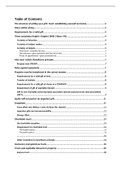Summary
Equity and Trusts summary of key principles, types of trust, actions against third parties, duties, defences
- Course
- Institution
Equity and Trusts summary of key principles, types of trust, actions against third parties, duties, defences
[Show more]



